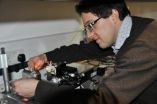Rhythms in the brain help give a sense of location, study shows
Scientists have shed light on how mechanisms in the brain work to give us a sense of location
2013-01-10
(Press-News.org) Research at the University of Edinburgh tracked electrical signals in the part of the brain linked to spatial awareness.
The study could help us understand how, if we know a room, we can go into it with our eyes shut and find our way around. This is closely related to the way we map out how to get from one place to another
Scientists found that brain cells, which code location through increases in electrical activity, do not do so by talking directly to each other. Instead, they can only send each other signals through cells that are known to reduce electrical activity.
This is unexpected as cells that reduce electrical signalling are often thought to simply supress brain activity.
The research also looked at electrical rhythms or waves of brain activity. Previous studies have found that spatial awareness is linked to not only the number and strength of electrical signals but also where on the electrical wave they occur.
The research shows that the indirect communication between nerve cells that are involved in spatial awareness also helps to explain how these electrical waves are generated.
This finding is surprising because its suggests that the same cellular mechanisms allow our brains to work out our location and generate rhythmic waves of activity.
Spatial awareness and the brain's electrical rhythms are known to be affected in conditions such as schizophrenia and Alzheimer's disease, so the scientists' work could help research in these areas.
The study, funded by the Biotechnology and Biological Research Council, is published in the journal Neuron. It looked at connections between nerve cells in the brain needed for spatial awareness in mice and then used computer modelling to recreate patterns of neural activity found in the brain.
Matt Nolan, of the University of Edinburgh's Centre for Integrative Physiology, said: "Rhythms in brain activity are very mysterious and the research helps shed some light on this area as well as helping us understand how our brains code spatial information. It is particularly interesting that cells thought to encode location do not signal to each other directly but do so through intermediary cells. This is somewhat like members of a team not talking to each other, but instead sending messages via members of an opposing side."
### END
ELSE PRESS RELEASES FROM THIS DATE:
2013-01-10
Royal Holloway is among a select group of top universities to receive £21.5 million in government funding to explore commercial uses for graphene.
Announced by the Chancellor of the Exchequer, George Osborne just after Christmas, the funding will focus attention on the so-called 'super-material' graphene, one of the thinnest, strongest and most conductive materials known to man.
The project at Royal Holloway will focus on using graphene to develop new equipment that can operate at high frequencies. This could include devices useful for security purposes, which can ...
2013-01-10
Southampton researchers have demonstrated that mothers who have higher levels of n-6 polyunsaturated fatty acids (PUFAs), which are found in cooking oils and nuts, during pregnancy have fatter children.
The study, carried out by the Medical Research Council (MRC) Lifecourse Epidemiology Unit, University of Southampton, assessed the fat and muscle mass of 293 boys and girls at four and six years, who are part of the Southampton Women's Survey (SWS), a large prospective mother-offspring cohort.
Their assessments were compared to the concentrations of PUFAs which were ...
2013-01-10
The University of Southampton's Optoelectronics Research Centre (ORC) is pioneering research into developing the strongest silica nanofibres in the world.
Globally the quest has been on to find ultrahigh strength composites, leading ORC scientists to investigate light, ultrahigh strength nanowires that are not compromised by defects. Historically, carbon nanotubes were the strongest material available, but high strengths could only be measured in very short samples just a few microns long, providing little practical value.
Now research by ORC Principal Research Fellow ...
2013-01-10
One of the most difficult problems in the field of genomics is assembling relatively short "reads" of DNA into complete chromosomes. In a new paper published in Proceedings of the National Academy of Sciences an interdisciplinary group of genome and computer scientists has solved this problem, creating an algorithm that can rapidly create "virtual chromosomes" with no prior information about how the genome is organized.
The powerful DNA sequencing methods developed about 15 years ago, known as next generation sequencing (NGS) technologies, create thousands of short fragments. ...
2013-01-10
Could marriage, and associated companionship, be one key to a longer life? According to new research, not having a permanent partner, or spouse, during midlife is linked to a higher risk of premature death during those midlife years. The work, by Dr. Ilene Siegler and colleagues from Duke University Medical Center in the US, is published online in Springer's journal Annals of Behavioral Medicine.
Survival through middle age to become elderly is expected; therefore understanding who does not survive to become elderly and why is important. Siegler and colleagues looked ...
2013-01-10
This press release is available in German.
Animals are more eloquent than previously assumed. Even the monosyllabic call of the banded mongoose is structured and thus comparable with the vowel and consonant system of human speech. Behavioral biologists from the University of Zurich have thus become the first to demonstrate that animals communicate with even smaller sound units than syllables.
When humans speak, they structure individual syllables with the aid of vowels and consonants. Due to their anatomy, animals can only produce a limited number of distinguishable ...
2013-01-10
The Mathematical Sciences in 2025, a new report from the National Research Council, finds that the mathematical sciences are an increasingly integral component of many disciplines -- including biology, medicine, the social sciences, business, advanced design, and climate studies. However, the expanding role of the mathematical sciences over the past 15 years has not been matched by a comparable increase in federal funding, and the number of federal agencies that provide significant support for this research is considerably smaller than the number that profit from it.
The ...
2013-01-10
New Rochelle, NY, January 10, 2013—Repeat traumatic brain injury affects a subgroup of the 3.5 million people who suffer head trauma each year. Even a mild repeat TBI that occurs when the brain is still recovering from an initial injury can result in poorer outcomes, especially in children and young adults. A metabolic marker that could serve as the basis for new mild TBI vulnerability guidelines is described in an article in Journal of Neurotrauma, a peer-reviewed journal from Mary Ann Liebert, Inc., publishers. The article is available free on the Journal of Neurotrauma ...
2013-01-10
WEST LAFAYETTE, Ind. - A new tool that could allow for faster, more comprehensive testing of brain tissue during surgery successfully identified the cancer type, grade and tumor margins in five brain surgery patients, according to a Purdue University and Brigham and Women's Hospital study.
The tool sprays a microscopic stream of charged solvent onto the tissue surface to gather information about its molecular makeup and produces a color-coded image that reveals the nature and concentration of tumor cells.
Researchers analyzed specimens removed from the patients, but ...
2013-01-10
ATHENS, Ohio (Jan. 10, 2013)—An international team of scientists has taken the next step in creating nanoscale machines by designing a multi-component molecular motor that can be moved clockwise and counterclockwise.
Although researchers can rotate or switch individual molecules on and off, the new study is the first to create a stand-alone molecular motor that has multiple parts, said Saw-Wai Hla, an Ohio University professor of physics and astronomy who led the study with Christian Joachim of A*Star in Singapore and CEMES/CNRS in France and Gwenael Rapenne of CEMES/CNRS. ...
LAST 30 PRESS RELEASES:
[Press-News.org] Rhythms in the brain help give a sense of location, study shows
Scientists have shed light on how mechanisms in the brain work to give us a sense of location




